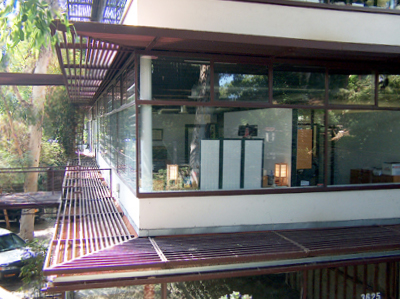|
Lloyd Ruocco, San Diego's Invisible Modernist
By Todd Pitman
The intricate beauty of the Villa Montezuma is clear to any passer by. The wonderful scale and geometry of the work of Irving Gill and the romance and proportion of the work of Richard Requa are evident to all (or most) who take the time to view any of these structures throughout our city. For people like myself who are inspired by the works of these designers and many others the simple pleasure of viewing our city's architectural treasures is a favorite pass time.

LLoyd Ruocco, AIA, The Design Center, c. 1950
Many of us have heard of and been exposed in some part to the incredible mid-century designs in LA and Palm Springs. The Case Study Program that harnessed the talents of the best of mid-century designers in Los Angeles from the forties to the sixties has received much attention in recent years from the droves of fans of modern design. Palm Springs has capitalized wonderfully on its modern heritage; hundreds of thousands of people are making Palm Springs their vacation destination once again, not only for the sun, martini's and golf but also for the incredible concentration of modernist works by some of the period's most talented architects.
That is why we as San Diegans need to learn to embrace our own modernist heritage. That's right; San Diego has wonderful modern architecture as well. In fact, I would say, that some of the fines modern structures in the country might be right here in our own city. Now certainly LA is a big place, they have more people and certainly more buildings but really San Diego has quite a few incredible examples of mid-century architecture, problem is, you can't see them. They hide from public view, tucked into canyons, lost amongst trees, shaded by blank facades of wood, masonry and stone.
The father of modern design in San Diego, Lloyd Ruocco, once said, "Good architecture should call for the minimum use of materials for the most interesting and functional enclosure of space." You see, Ruocco believed that no level of architectural genius could equal the beauty of San Diego's natural landscape. He believed in the beauty of the trees, canyons and sky and if you have had the pleasure of being inside one of his simple wood or steel buildings you know the trees, canyons and sky of which I speak.
Unlike most architects who came before him, Ruocco did not feel the need to build his ego with grand architectural statements, buildings that impressed and were impossible to miss. He believed that as an architect he had a responsibity to the people, that the building's impact on the land should be as minimal as possible, and that it should be the experience of those who live and work within the structure that matters. Further, he believed structure obscured that which is most grand (see trees, birds sky above). To this point many of Ruocco's works are invisible from the street, that is to say they cannot be seen by simply passing by.
Once inside a Ruocco-designed home, structure becomes secondary at best. Light and shadow define the space as no amount of man-made muckity muck could. After all we live in a beautiful place why not enjoy it from the inside as well.
Sometimes an architect's greatest achievement is what he does not do. Lloyd Ruocco provided our city with amazing spaces that highlight our region's natural beauty. So as you travel our city in search of our finest of architectural treasures walk a little farther down the street, peer down into the canyon, you might just catch a glimpse of the sky, trees and shadows, and when you do...thank Lloyd.
|
MORE FROM THIS ISSUE
Historic Otay City Threatened with Destruction
Historic Resources Board may be eliminated
Graves / Top Gun House
Scheming on Presidio Park
Craftsman & Spanish Revival Weekend 2005 Roundup
Borrego Springs Modern
Lloyd Ruocco, San Diego's Invisible Modernist
People in Preservation Award Winners
Book Review of Bungalow Details: Exterior
Whaley House & SOHO Museum Shop Summer Hours
Found San Diego
Strength in Numbers
Lost San Diego
DOWNLOAD full magazine as pdf (3.3mb)
|




